 COUNTRY OF ORIGIN
COUNTRY OF ORIGIN• Spain
A return to the use of natural dyes
A return to the use of natural dyes in practice
A RETURN TO TRADITIONAL CRAFTWORK TECHNIQUES IN A REGION OR CULTURE
Bibliographic information
The first step in setting up a project of this kind is to provide interested groups with existing literature on the different aspects of dye production: historical, technical, chemical and botanical. Publications on this topic can be found practically all over the world.
Selected bibliography:
• Böhmer, Harald: Koekboya, Natural Dyes and Textiles, REMHÖB-Verlag, Ganderkesee (Germany) 2002
• Brunello, F.: L’Arte della Tintura nella Storia dell’Humanitá, Neri Pozza, Vicenza (Italy) 1971
• Cardon, Dominique: Le monde des teintures naturelles, Éditions Belin, Paris (France) 2003
• Dean, Jenny: The Craft of Natural Dyeing, Search press, Tunbridge Wells, Kent (United Kingdom)1994
• Garcia, Michel: Plantes colorants - Teintures Végétales, Édisud, Aix-en-Provence (France) 2006
• Roquero, Ana: Tintes y tintoreros de América - Catálogo de materias primas y registro etnográfico de México, Centroamérica, Andes Centrales y Selva Amazónica, Instituto del Patrimonio Histórico Español, Madrid (Spain) 2006
These books include classifications of dye plants, descriptions of their characteristics, details of their distribution and summaries of traditional dyeing techniques used in different parts of the world. These works can be used as a starting point for the practices.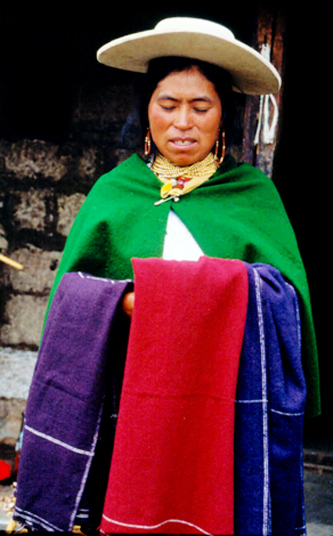
Woollen fabrics dyed with cochineal and various colour modifiers (ash and lemon juice), Salasaca (Tungurahua, Ecuador)
Looking into the viability of setting up practices in a region
Research should be conducted by a person or a team with a solid knowledge of the dyeing process and its chemical and botanical basis. This person or team should also have experience in ethnographic research. The methodology involves:
Ethnographic research
Ethnographic research will be carried out to record the current processes used in an area or find out about them from local people. The information obtained may well be incomplete, fail to correspond entirely to traditional uses or even be erroneous. This is why the interviewer must be well-versed in the subject to determine the degree of validity of the information.
This information can be recorded in writing and, if possible, filmed so that it can be transmitted to those who are attempting to rediscover the techniques.
The study of dye plants
Dye plants will be studied in the area where the project is to be carried out primarily for ethno-botanical purposes. A herbarium will be created using bibliographical information, contributions from the local population, and in collaboration with the botany departments of the country’s scientific institutions. A study will be made of the viability of cultivating the species that have been collected because it is important that use is not made of plants in the wild.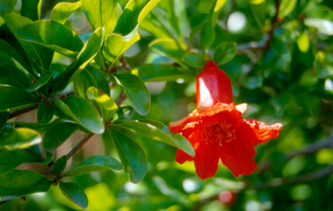
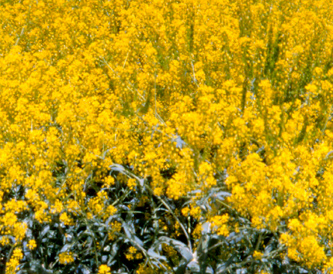
Cultivation and recycling
The last step involves the localisation of land suitable for the cultivation of the selected plants and contacting farmers interested in the project.
Mention should be made of the recent experiment in the use of an integral strategy for the sustainable exploitation of natural dyestuffs, called ‘Jardín y Bosque del Tintorero’, which is being carried out jointly by the Mexican anthropologist Marta Turok and the local dyers from the village of Xochistlahuaca (Guerrero, Mexico).
At the same time contact will be made with sawmills, vegetable markets and plant-nurseries, and so on to establish a plan for the recycling of waste.
Dyeing of fibres and fabrics
Colour samples
Once the dyestuffs available in the project area are known, colour samples will be created for possible use by local dyers. These samples will be accompanied by information on utilisation procedures and auxiliary products needed to render each colour fast.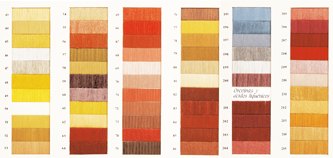
Technical training and project follow-up
Setting up a dye project necessarily involves training for local technicians, who will stay in the country to permanently monitor production. These technicians will be liaising with local producers and international technical assistance organisations.
Creating infrastructure
Advice on the infrastructure needed for dye production is equally important. A study will be carried out on the best systems for obtaining heat (preferably solar burners), handling dye waste material, and saving water. These aspects will be studied by experts (chemists and biologists).
Commercial assistance
Finally, it is vital that producers are given expert advice on marketing, since without this all previous efforts would be wasted.
INDUSTRIAL PRODUCTION
Assistance to enterprises that wish to begin natural dye production and/or application will be provided by experts in traditional dyeing, textile engineers and agriculturalists.
This kind of project involves start-up phases in different production areas:
• Cultivation of dye plants
• Colour extraction
• Dye application
Supply of raw materials
A regular supply of raw materials is vital to guarantee the production of dyes on an industrial scale, so it is important to plan the cultivation of dye plants.
Start-up
The traditional cultivation of dye plants such as madder, weld and woad was common in Europe until the beginning of the 20th century and it has been revived in countries such as France and Holland. In other parts of the world (Asian countries) cultivation of the indigo plant has never ceased. At present, there are enough books on the cultivation of dye to provide a useful starting point.
The selection of suitable species in each region and the localisation of suitable land for cultivation will be carried out by agricultural engineers, who, in turn, will contact farmers interested in the project.
Supply using established producers
Raw materials for colour extraction industries can also be provided by established cultivators. Below is a list of cultivated products and the countries that produce them:
• Cochineal (red) - Canary Islands, Peru and Mexico
• Indigo (blue) - El Salvador
• Woad (blue) - France
• Weld (yellow) - France
• Madder (red) - Holland
• Plantain (yellow) - France
• Woundwort (yellow) - France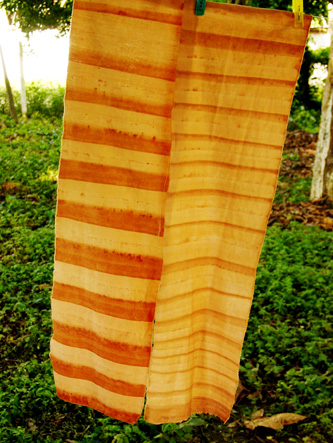
Cloth dyed with mahogany residues
Dye products from recycled material
As in the case of artisanal dyes, the necessary contacts will be made with sawmills, vegetable markets, plant nurseries etc to produce a plan for the recycling of waste material: wood bark, avocado seeds, onion skins, pomegranate skins etc.
Colour extraction
Infrastructure and method
Technical assistance for colour extraction plants and procedures will be provided by chemists and the textile engineers.
Dye application
Collection of colour samples
As with the project on artisanal dyes, an expert in natural dyes will provide dye factories with colour samples together with information on the dyestuffs used, application procedures and products needed to render each colour fast.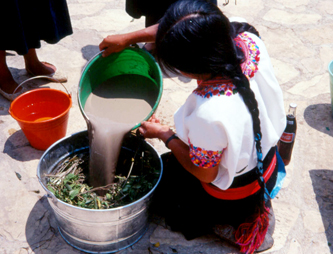
Ethical and sustainability criteria
Industrially produced[b] dyes and naturally dyed fibres and fabrics must be certified as clean, that is, they must adhere to the following standards:
[b]• Legal and fairly paid labour is employed in each production phase
• Dye plants are not picked in the wild
• No toxic products are used in dye making
• Waste material contains no contaminants
• Water and energy is used in reasonable amounts
Enterprises will be given the name and address of organisations that validate sustainability labels.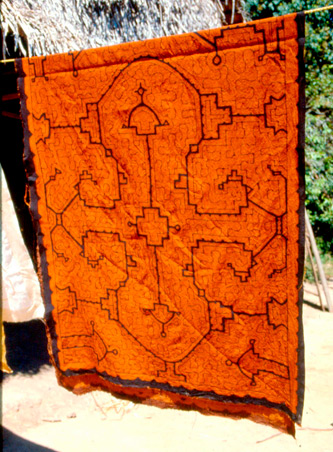

Marketing of naturally dyed textile products from a dye workshop in Madrid
DOWNLOAD THE BROCHURE PDF
Spanish (1.0 MB)English (1.0 MB)







